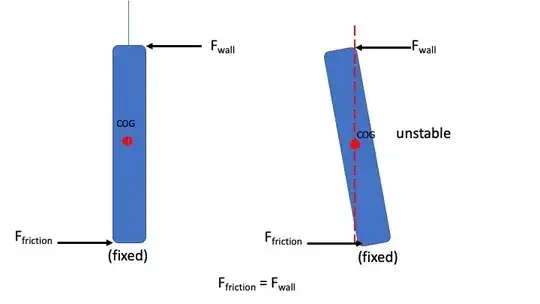In the expression in the OP, $F$ is the force exerted by the person on the wall, but $F_{\textrm{fr}}$ (which really should be $F_{\textrm{normal}}$) is the force exerted on the person by the wall.
You should never be subtracting these.$^1$
Newton's second law says that the net force exerted on an object determines the force exerted on that object, i.e.,
$$
m_{\textrm{person}}\vec{a}_{\textrm{person}}
=
\vec{F}_{\textrm{net on person}}
=
\mbox{(sum of forces on that person)}\,.
$$
Nowhere in the expression should the force exerted by the person on the wall show up. This is a very common mistake made by students learning physics for the first time, and it always comes into conflict with Newton's 3rd Law. That is, the confusion arises because Newton's 3rd law says that the forces exerted between the person and the wall must be equal and opposite, but then how could there be a net force? Well, again, the point is that acceleration is caused by the net force exerted on the object, and it doesn't matter what forces that object is exerting on other things.
$^1$With the caveat that we need to generalize this statement i n the following way. When computing the motion of a single particle, only consider the forces acting on that particle. When computing the motion of the center of mass of a system of particles, only consider the forces exerted by objects outside the system on objects inside the system. The forces exerted by objects inside the system "cancel" in the sense that they don't contribute to the motion of the center of mass.
How does the normal force exerted on the person by the wall arise? We imagine the wall as a very stiff spring. The person pressing into the wall compresses this spring, leading to a spring force exerted by the wall on the person. The wall being very stiff, we can't really detect this microscopic compression with our hands, because the displacement of the wall is extremely small, but it's there, and it leads to the wall pushing back on the person.
Why does the person move and not the wall?
While the forces exerted by the person and the wall on each other are equal and opposite, the results of these forces are not, and that's because the wall is much more massive than the person (in fact, the wall, being connected to the Earth, is part of the Earth and therefore much more massive). Since the acceleration is the net force divided by the mass, the wall has a much smaller acceleration.
What causes the motion of the person?
The resultant motion of the person is in fact more complicated to analyze. Imagine a spring attached to and compressed against a wall. The force exerted by the wall on the spring acts at the point of contact. We release the spring, and it expands outward away from the wall (but it is still connected to the wall). The point of contact doesn't move as the spring expands, and so, paradoxically, despite the fact that the wall is exerting a force on that point on that part of the spring, the spring experiences no acceleration. How does that not contradict Newton's 2nd law?
Well, the part of the spring connected to the wall is being pushed backward toward the wall by the next part of the spring that it's connected to, and so on down the spring. The net result is that the center of mass of the spring experiences an acceleration determined by Newton's 2nd Law in the form of
$$
m_{\textrm{spring}}\vec{a}_{\textrm{spring COM}} = \vec{F}_{\textrm{net}} = \vec{F}_{\textrm{N, by wall on spring}}\,.
$$
The main idea is that the inner structure of the system (the spring, or a person with muscles flexing and tendons pulling) determines the net result of the force exerted by the wall.
